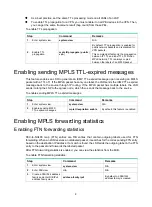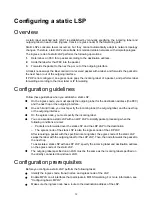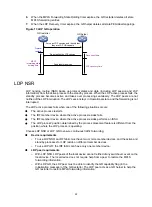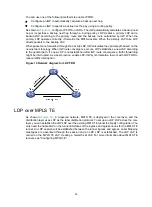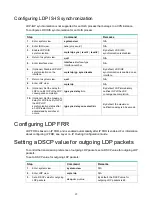
23
LDP-IGP synchronization
Basic operating mechanism
LDP establishes LSPs based on the IGP optimal route. If LDP is not synchronized with IGP, MPLS
traffic forwarding might be interrupted.
LDP is not synchronized with IGP when one of the following situations occurs:
•
A link is up, and IGP advertises and uses this link. However, LDP LSPs on this link have not
been established.
•
An LDP session on a link is down, and LDP LSPs on the link have been removed. However, IGP
still uses this link.
•
The
Ordered
label distribution control mode is used. IGP used the link before the local device
received the label mappings from the downstream LSR to establish LDP LSPs.
After LDP-IGP synchronization is enabled, IGP advertises the actual cost of a link only when LDP
convergence on the link is completed. Before LDP convergence is completed, IGP advertises the
maximum cost of the link. In this way, the link is visible on the IGP topology, but IGP does not select
this link as the optimal route when other links are available. Therefore, the device can avoid
discarding MPLS packets when there is not an LDP LSP established on the optimal route.
LDP convergence on a link is completed when both the following situations occur:
•
The local device establishes an LDP session to a minimum of one peer, and the LDP session is
already in
Operational
state.
•
The local device has distributed the label mappings to a minimum of one peer.
Notification delay for LDP convergence completion
By default, LDP immediately sends a notification to IGP that LDP convergence has completed.
However, immediate notifications might cause MPLS traffic forwarding interruptions in one of the
following scenarios:
•
LDP peers use the
Ordered
label distribution control mode. The device has not received a label
mapping from downstream at the time LDP notifies IGP that LDP convergence has completed.
•
A large number of label mappings are distributed from downstream. Label advertisement is not
completed when LDP notifies IGP that LDP convergence has completed.
To avoid traffic forwarding interruptions in these scenarios, configure the notification delay. When
LDP convergence on a link is completed, LDP waits before notifying IGP.
Notification delay for LDP restart or active/standby switchover
When an LDP restart or an active/standby switchover occurs, LDP takes time to converge, and LDP
notifies IGP of the LDP-IGP synchronization status as follows:
•
If a notification delay is not configured, LDP immediately notifies IGP of the current
synchronization states during convergence, and then updates the states after LDP
convergence. This could impact IGP processing.
•
If a notification delay is configured, LDP notifies IGP of the LDP-IGP synchronization states in
bulk when one of the following events occurs:
{
LDP recovers to the state before the restart or switchover.
{
The maximum delay timer expires.
LDP FRR
A link or router failure on a path can cause packet loss until LDP establishes a new LSP on the new
path. LDP FRR enables fast rerouting to minimize the failover time. LDP FRR is based on IP FRR
and is enabled automatically after IP FRR is enabled.

